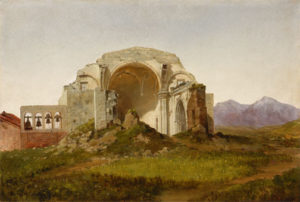Paintings in Inventory (Click on an image for a larger view)
Lemuel Wiles grew up in upstate New York and studied art with William Hart and Jasper Cropsey before launching into a career as a landscape painter and art teacher. He was a frequent exhibitor at National Academy and Brooklyn Art Association Exhibitions. In 1873-1874, Wiles traveled to California via Panama, and settled for a time in San Diego, which was home base for sketching tours to the San Luis Rey and San Juan Capistrano Missions. He visited the latter place in late February and early March of 1874, when his presence was noted by Hubert Bancroft and Henry L. Oak, who were touring historic sites in Southern California. Wiles was the first professional oil painter to make color studies of these missions, and our recently-rediscovered work was one of these paintings, done outdoors on location. Wiles exhibited some of these studies upon his return to the east coast, and they caught the attention of the New York Post art critic who praised them as being “attractive.” (March 17, 1875). Later in the decade the art historians Clement and Hutton singled out the studies as being “valuable as the only studies in color yet obtained of old mission churches.” (Artists of the Nineteenth Century, published in 1879, p. 351). Our painting depicts the ruins of the great stone church built between 1797 and 1806 from sandstone quarried six miles away. For several years the mission flourished around this magnificent edifice, the most sophisticated building in all of Alta California. Then in December 1812, a tremendous earthquake caved in the roof during a religious service, killing thirty-nine people and injuring many others. The mission went into decline and by 1874 was the ruined hulk in Wiles’s painting. Wiles has accurately captured the mission in wintertime, with green grass in the foreground and snow in the distant mountains. It is a rare and unique historical painting done by an esteemed professional painter at the top of his powers.
